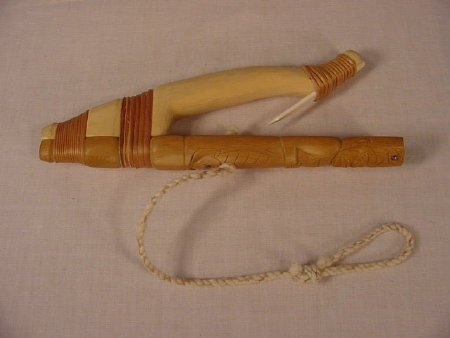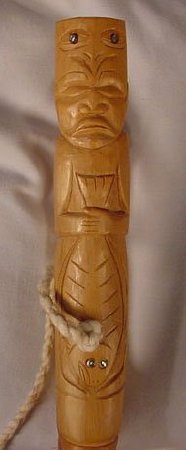Collection:
Juneau—Douglas City Museum
Object ID:
2005.54.001
Accession#:
2005.54
Credit Line:
Purchased with the generous support of the Rasmuson Foundation
Object Name:
Hook, Halibut
Title:
Halibut Hook "Spirit Keeper of the Halibut in a Trance"
Artist — Creator:
Gregory, Donald (Heendei)
Date:
01/012005
Description:
Halibut hook made of two different kinds of wood lashed together with split spruce root. The darker wood (yew) is a flat piece that faces downward, carved with the figure of a man wearing a headdress and holding a fish by the tail. The eyes on the shaman's headdress and the halibut are inlaid with abalone shell. Corage pierces the wood in the middle of the fish's body, and is secured on the inner part with a knot and a washer made from carved bone. The lighter piece of wood (yellow cedar) is curved and has a large spike made of bone (bear femur) attached to the end at an angle. This line is mountain goat hair twined with cedar bark with a loop on the end. Behind the head of the shaman the artist has carved his name, "By Heendei"
Notes:
Donald Gregory is a Tlingit of the Raven Moiety, Deisheetaan clan (Raven/Beaver), Deishu Hit (End of the Trail House of Angoon.) Gregory lives and works in Juneau where his art is on display in public buildings such as the Sealaska Building and for sale in several local galleries. He has taught halibut hook carving classes at the Juneau—Douglas City Museum for the several years, and estimates he has probably carved close to 100 halibut hooks in his career. This particular hook is special because it is the first time the artist used yew wood. According to the artist, yew wood was the strongest wood available from the forests of the Northwest Coast, and traditionally used to make the carved section because its weight would help that part face downward, keeping the hook in proper orientation. Most carvers, himself included, today carve the entire hook from yellow cedar, since its function is now aesthetic. The halibut hooks made as art today are also hung upside—down from their utilitarian orientation. Other non—traditional elements typical of Gregory's style are the abalone inlays and the use of "Chilkat warp" for the line. This particular Chilkat warp was made from cedar bark and mountain goat wool by prominent local weaver Anna Brown Ehlers. The design is Gregory's own, incorporating the spirit keeper of the halibut in a trance. According to the artist, his design is a departure from tradition because the bird on the figure's head is a "neutral bird, open to individual interpretation. One can't tell if it is Raven or Eagle." In general, the JDCM tries to collect fine art that can also interpret other themes related to our mission, and this artwork can be used to interpret both contemporary carving and the traditional uses of the halibut hook. Our collection contains an early 20th century utilitarian halibut hook, a hook carved by George Dalton in 1975 for the tourist trade, and several examples of non—Native fishing gear. This hook demonstrates the progression of the halibut hook form into a contemporary art piece.
People:
Gregory, Donald
Ehlers, Anna Brown
Ehlers, Anna Brown
Search Terms:
fishing
subsistence
Native
Tlingit
subsistence
Native
Tlingit


